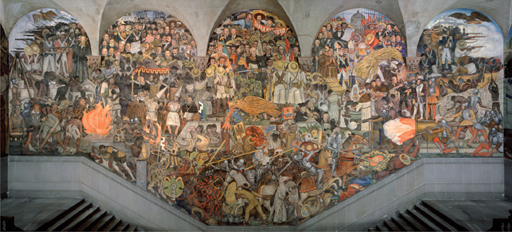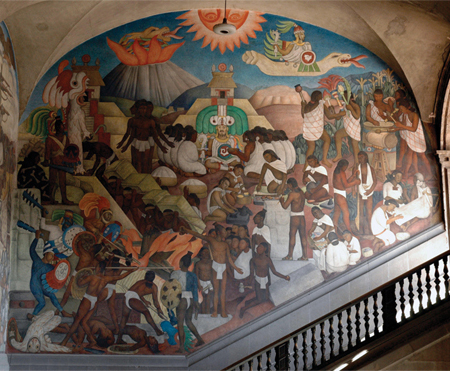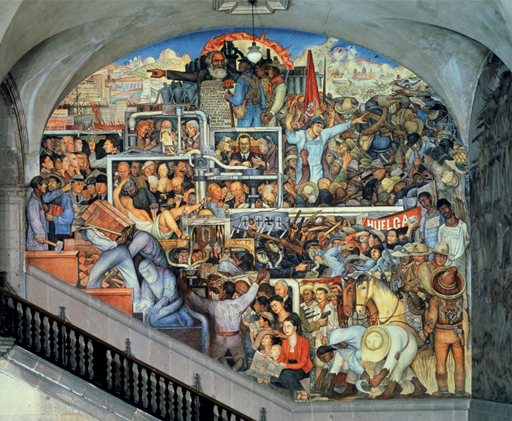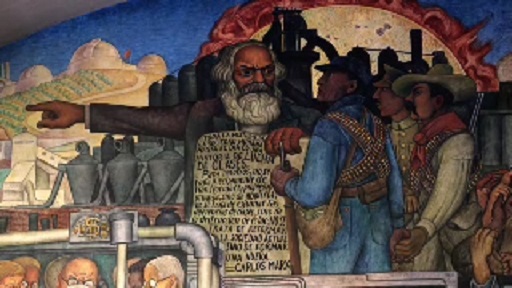4 The mural interpreted
The nationalism that shaped the Mexican Revolution was also an important component of Rivera’s iconographic scheme. The passages on the top right and top left in From the Conquest to the Present that depict the nineteenth-century invasions by the United States and the French respectively are triangulated by the scenes of conquest at the bottom middle led by Cortés on his horse.

The art historian Leonard Folgarait has pointed out that the significance of these details is underscored by the fact that the departing eagles in both side scenes are repeated by the central motif of the eagle in the middle of the composition, an obvious nationalist reference to the Mexican flag, which also has an eagle at its centre (Folgarait, 1998, p. 114). The eagles all fly in the same direction, which strengthens this visual symmetry, and hence their iconographic and narrative importance.
Immediately below the central eagle is the figure of Cortés on horseback in combat with an Aztec warrior, which, according to another art historian, Desmond Rochfort, can be read as ‘the first great struggle against foreign domination’ (Rochfort, 1987, p. 60). This fight against colonialism is taken up again, above the eagle, in the figures of the two priests Miguel Hidalgo and José María Morelos, nationalist leaders who played a pivotal role in the build-up to the overthrow of Spanish rule in 1821.
The fight against imperialism is then brought up to the present with the depiction of Zapata, at the very top of the central bay, with the banner proclaiming ‘Tierra y Libertad’ (land and liberty). This was Zapata’s revolutionary slogan and was adopted by the peasantry, who appropriated many of the great estates owned by landed interests in the United States after 1910 (Hart, 1989, pp. 159 and 243).
It was this component of the revolution that Rivera supported. The bourgeois governments after 1920 deployed the nationalist card to win over the revolutionary peasantry and secure power. The murals were meant to be part of this process of propaganda to support their rule. Yet the political agenda of the post-revolutionary regimes that commissioned the murals was not as revolutionary as the more radical sections of the peasantry, or the muralists themselves for that matter.
The anti-imperialism of the bourgeoisie was borne more out of a desire to pursue its own economic and political self-interest, free from colonial domination. Yet once in power, successive bourgeois governments were more than prepared to negotiate with the government of the United States that had, in fact, helped them defeat the forces of Zapata and Villa, and to bring the period of revolutionary violence to a close (Hart, 1989, pp. 320 and 344–5). As a result of this, the process of land redistribution slowed and the class contradictions that largely fuelled the revolution remained in place.

It is the focus upon class conflict in the two side walls of Rivera’s mural that undercuts the focus upon nationalism in the main one. Several commentators have agreed that the detail of pre-Columbian Indians fighting in the bottom left section of The Aztec World is a symbol of aboriginal class struggle (Catlin, 1986, p. 262; Craven, 2002, p. 56; Folgarait, 1998, p. 99).This emphasis upon class conflict as the motor of human history (central to Rivera’s Marxist analysis of Mexican society) becomes even more explicit in the details that you can see in the opposite wall, depicting Mexico Today and Tomorrow. This was painted in 1934–35, after Rivera had returned from producing important murals for corporate patrons north of the border, and after Calles’s domination of the executive had finally been supplanted by the more progressive regime of Cárdenas.
The side walls are linked iconographically as well as thematically. The departing figure of Quetzalcóatl, who rides out of the Aztec world on a feathered serpent to the right, thereby setting the scene for the Spanish invasion beginning in the bottom right of the main wall, has a visual symmetry in the opposite wall with the figure of Marx. He is pointing out of the mural scheme to the left, beyond the idealised utopia, to a classless future, which for Rivera was the desired outcome of the as yet unfinished revolutionary process.

Recent accounts of Mexican muralism have highlighted the conservative nature of the Mexican post-revolutionary governments and have read the ideological content of the murals commissioned by them accordingly (Coffey, 2012; Folgarait, 1998). However, it can be argued that Rivera’s History of Mexico cuts against such an interpretation of the murals as propaganda for the post-revolutionary bourgeois regimes pure and simple. The emphasis upon Mexican nationalism, which is so significant in the central wall and so pivotal in governmental attempts at winning support for their policies post-1920, is just part of a broader historical struggle rooted in class conflict. This is highlighted in the south wall by the detail of Calles being surrounded by the army and the clergy, and, to the right, by the pitched battles between the conservative forces of Calles and the supporters of the newly elected Cárdenas that were taking place in the Zócalo as Rivera painted. Indeed, Cárdenas’s redistribution of land to the peasantry in line with what Zapata and Villa had fought for, and the nationalisation of Mexican subsoil resources in 1938, were achieved on the back of this grass roots popular support. For Rivera, the Mexican Revolution was far from finished and it was the job of his mural to signal this to the more radicalised sectors of the workers and peasantry, and thereby agitate for further political and economic gains.
Activity 1
Rivera’s mural sequence is massive and extremely complex in terms of its iconography which is difficult to read in small-scale reproductions. To get a better sense of what it looks like, and to consolidate what you’ve learned so far, as well as to prepare you for what will follow, watch this short film about History of Mexico before continuing to Section 5.

Transcript
[MUSIC PLAYING]
[MUSIC PLAYING]
[MUSIC PLAYING]
